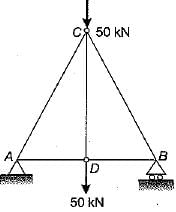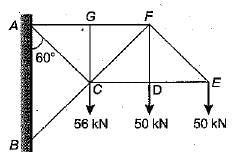Test: Trusses -2 - Civil Engineering (CE) MCQ
10 Questions MCQ Test GATE Civil Engineering (CE) 2026 Mock Test Series - Test: Trusses -2
The force induced in the vertical member CD of the symmetrical plane truss shown in the figure is


Consider the following Assumptions in the analysis of a plane truss:
1. The individual members are straight.
2. The individual members are connected by frictionless hinges.
3. The loads and reactions acts only at the joints.
Which of the following assumptions are valid?
1. The individual members are straight.
2. The individual members are connected by frictionless hinges.
3. The loads and reactions acts only at the joints.
A loaded pin-jointed truss is shown in the given figure. The force in member AC is


Which one of the following is the correct statements regarding the force and deflection at point B in trusses I and II shown in the figure?

A truss ABC carries two horizontal and two vertical loads, as shown in the figure. The horizontal and vertical components of reactions at A will be

In the plane truss shown below, how many members have zero force?

In the pin-jointed plane truss shown below, what is the magnitude and nature of force in member BC?

Due to horizontal pull 60 kN at C, what is the force induced in the member AB?

|
31 docs|280 tests
|




























